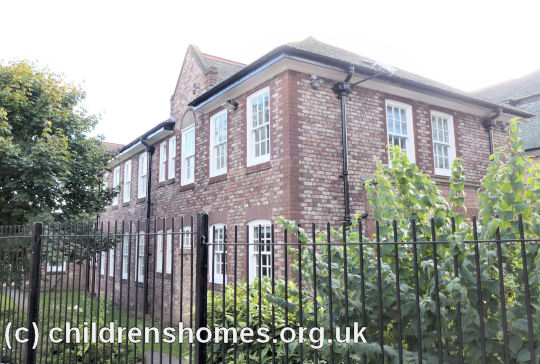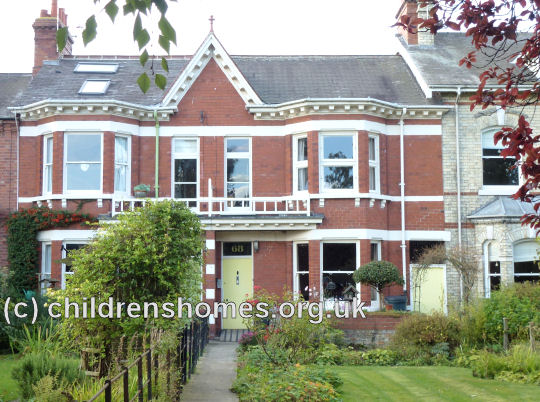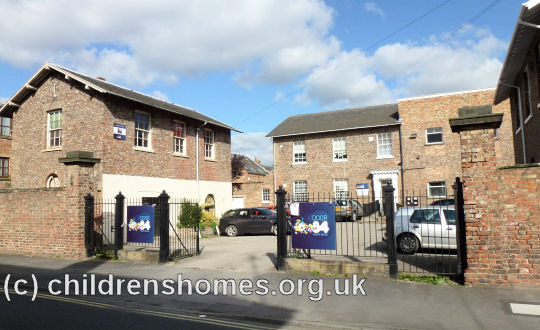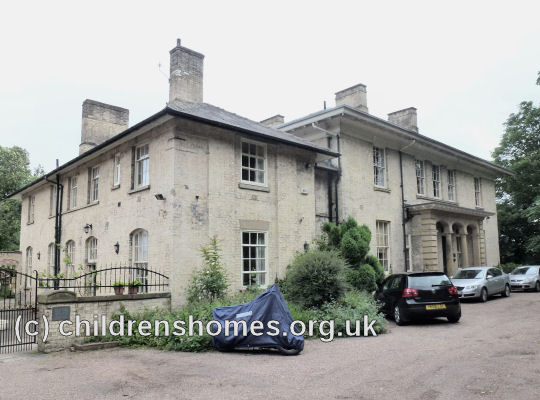York Council Homes
In 1930, following the abolition of the York Poor Law Union, the York Corporation took over responsibility for the administration of poor relief in the city. This included the children's homes previously run by the union, which now came under the management of the council's new Public Assistance Committee.
The homes initially operated by the council are listed below.
| Location | Places |
|---|---|
| Central Home, Haxby Road | 26 |
| Infants' Home, The Elms, 160 Hull Road | 35 |
| 44 East Mount Road | 12 |
| 120 Haxby Road | 12 |
| 68 Wigginton Road | 12 |

Central Home, Haxby Road, York. © Peter Higginbotham

68 Wigginton Road, York. © Peter Higginbotham
By 1933, 44 East Mount Road had been closed and the Central Home relocated to the former York Girls' Industrial School premises at 84 Lowther Street, known as St Hilda's. The superintendent in 1935 was Miss A.M. Ham. In 1936, it was described as a Receiving Home, with Mrs Jessie James as superintendent. It was referred to as the Central Home in 1942, with Mrs James still in charge. By 1945, Mrs L.K. Baldwin had become superintendent, succeeded in 1947 by Miss A. McGuire.
By 1940, 68 Wigginton Road had been replaced by a home at 4 Feversham Crescent. The Elms was closed at around the same time but re-opened in around 1946. In 1945, a new home was opened at 46 Burton Stone Lane but had closed within a year or two.
Following the passing of the 1948 Children Act, councils were required to provide care services for all needy children in their area, especially those who lacked a normal family home. In common with other local authorities, the council established a new Children's Committee, whose responsibilities had previously been spread across separate Health, Education and Social Welfare Committees. Under the new regime, residential care was seen as the least desirable option for children in care, but when it was employed, the recommended size of home was eight children, or twelve at most. The council's children's accommodation in 1949 comprised:
| Location | Places |
|---|---|
| St Hilda's, Lowther Street | 51 |
| 4 Feversham Crescent | |
| 120 Haxby Road | |
| The Elms, Hull Road | 20 |

Former St Hilda's Home, Lowther Street, York. © Peter Higginbotham
As well as these children's homes, the council also became responsible for a Remand Home at Ashbank House, Shipton Road, Clifton.
By 1950, the council had opened a second residential nursery known as The Glen, on Bull Lane, in the city suburb of Heworth. This was quickly followed by a new home at 103A Danebury Drive, Acomb. In around 1955, the Elms nursery was taken over by the West Riding County Council. In the same year, St Hilda's moved to the former Clifton Holme Approved School premises at Ousecliffe Gardens, Clifton. By 1961, new homes were in operation at 6 Nursery Drive, Acomb, and 249 Kingsway North, York. In 1963, the council-run Stockton Hall Approved School was opened at Stockton-in-the-Forest. Another children's home was opened by 1968 at 9 Ashford Place.

Former St Hilda's Home, Ousecliffe Gardens, York. © Peter Higginbotham
The council's children's establishments in operation in 1968 are listed below.
| Location |
| St Hilda's, Ousecliffe Gardens |
| 249 Kingsway North |
| 6 Nursery Drive |
| 9 Ashford Place |
| 103A Danebury Drive, Acomb |
| The Glen Nursery, Bull Lane, Heworth |
| Ashbank House Remand Home, Shipton Road |
| Stockton Hall Approved School, Stockton-in-the-Forest |
The Glen Nursery moved to a separate part of the Ousecliffe Gardens site in around 1969.
Following the local government reorganisation that took place in 1974, the borough became a non-metropolitan district in the county of North Yorkshire. Its children's homes were then taken over by the new North Yorkshire County Council.
Children's establishments run at some time in their history by York Council.
- Ashbank House Remand Home, 1 Shipton Road, Clifton, York
- 103A Danebury Drive, Acomb, York
- York Union/Council Scattered Home, 120 Haxby Road, York*
- 249 Kingsway North, York
- Home for Boys, 4 Feversham Crescent, York
- 46 Burton Stone Lane, York
- 6 Nursery Drive, Acomb, York
- York Union/Council Scattered Home, 68 Wiggington Road, York*
- 9 Ashford Place, Acomb, York
- The Glen Residential Nursery, Bull Lane, Heworth, York
- York Union/Council Receiving Home, Haxby Road, York*
- St Hilda's Garth Reception Centre, Ousecliffe Gardens, York
- The Glen Residential Nursery, Ousecliffe Gardens, York
- Central Home, St Hilda's, 84 Lowther Street, York
- Stockton Hall School, Stockton on the Forest, York
- York Union/Council Scattered Home (Infants), The Elms, 160 Hull Road, York*
* indicates link to pages on www.workhouses.org.uk.
Records
The involvement of local authorities in the running of children's homes dates from 1930, when they took over the running of the poor relief system previously administered by Boards of Guardians. Surviving records for council-run children's homes may be held in each council's own internal archives. Prior to 1991, however, when a legal requirement was introduced for councils to retain records of children leaving their care, the survival of such records is very variable. Contact details for local authorities in the UK can be found on the website of the Care Leavers Association (CLA). The CLA also provides guidance on accessing childhood care files, which are normally only open to the individuals they relate to.
Locating local authority records has been complicated by the various local government reorganizations that have taken place in recent times, such as the abolition of the London County Council in 1965, and the major nationwide restructuring in 1974 in which many administrative areas were created, amended or eliminated.
Older records may sometimes be placed with the relevant county or borough record office. Many of these repositories have online catalogues of their holdings and also contribute to the National Archives' Discovery database. Note that records containing personal data usually have access closed for a period of fifty years or more.
Older material relating to York Council homes may exist at:
- York City Archives, York Explore Centre, Museum Street, York YO1 7DS.
Some records relating to council-run homes, for example inspection reports (though not resident lists etc.), are held by The National Archives (TNA). A closure period may apply to these records.
Bibliography
- Higginbotham, Peter Children's Homes: A History of Institutional Care for Britain's Young (2017, Pen & Sword)
- Urquhart, Gloria (2020) Nobody's Child: The True Story of Growing up in a Yorkshire Children's Home
- Cooke, Allan Institutionalized in a Children's Home: Skellow Hall 1950-1963 — a true story of a child and children in a home (2012, Authorhouse)
- Cummings, Les Forgotten: The Heartrending Story of Life in a Children's Home
- Limbrick, Gudrun The Children of the Homes: a century of Erdington Cottage Homes
Except where indicated, this page () © Peter Higginbotham. Contents may not be reproduced without permission.


